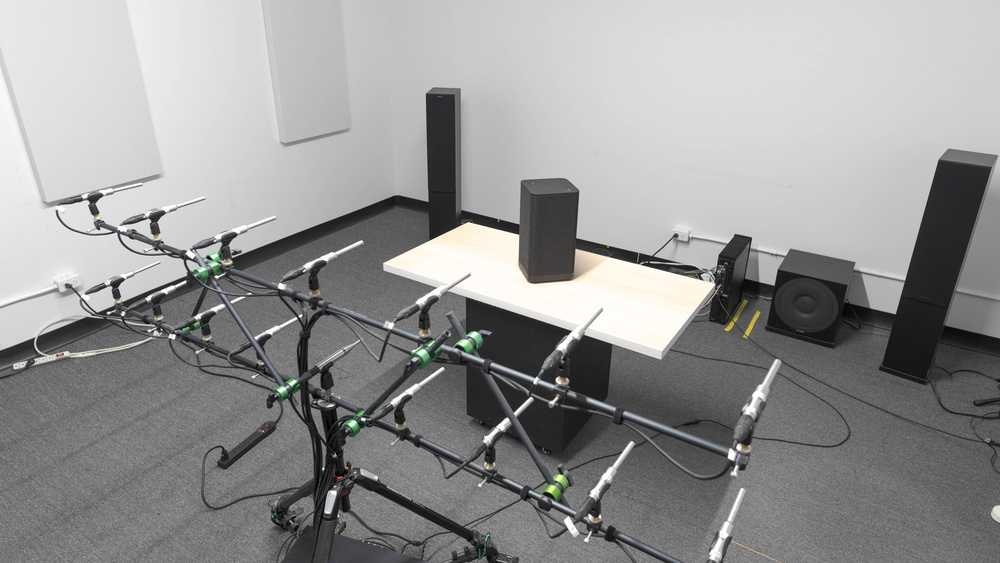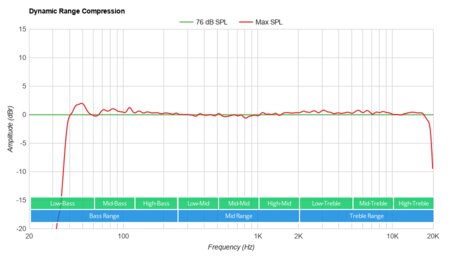- 60.0%SPL @ Max Volume
- 40.0%DRC @ Max Volume
When you're looking at a speaker's sound profile, it's important to look at its dynamics performance. This indicates how loud a speaker can get and whether its audio production remains clean when you push it to max volume. You may want something that can get very loud if you expect to use it in crowded rooms or outdoors. It's generally preferable for a speaker to have less compression present at max volume, which ensures it still has a balanced sound profile without any pumping artifacts.
These two factors—sound pressure level at max volume and dynamic range compression at max volume—comprise a speaker's dynamics performance. Although dynamics don't indicate the kind of sound profile, it gives you important information about the performance at max volume.
Test results
When It Matters
Dynamics matter if you want a speaker that can get loud, and you expect to be using it at max volume. Speakers with a high max volume are generally more suitable for use at parties, in large rooms, or outdoors. Most listeners prefer that a speaker's audio production remains clean and pure when it's pushed to max volume, without much compression present. Although not all users are looking for something that can get very loud, it's helpful to understand how dynamics affect the overall listening experience.
Our Tests
Testing a speaker's dynamics centers around two distinct tests: sound pressure level (SPL) at max volume and dynamic range compression (DRC) at max volume. SPL at max volume tests how loud a speaker gets, in decibels (dB), when played at max volume. This is a fairly simple test, although it may not be clear to everyone how loud a speaker they should look for. Generally, it's preferred to have a louder speaker (>92 dB) if you want to use it at parties, in large rooms, or outdoors. However, individual preference may vary. DRC at max volume tests how much compression is present when using the speaker at max volume. If a speaker doesn't have much compression present at max volume, its audio production remains clean and pure. We discuss both tests in more detail below.
SPL @ Max Volume
Sound pressure level at max volume, or SPL @ max volume, is a measurement of how loud a speaker gets when it's pushed to max volume. You may want something that can get loud if you plan on using it at parties, in crowded rooms, or outdoors. If a speaker has a battery, we test it on battery power, and if not, we test it using its AC power adapter. The SPL @ max volume is measured in decibels (dB) using a microphone array, as pictured below. The speaker is tested in a basic room measuring 20' (L) x 16' (W) x 9.5' (H), at both one meter and two meters away from the microphone array. Although we set >92 dB as a good value for a speaker's SPL @ max volume, different listeners may have different preferences. Depending on how you want to use a speaker, you may not need one that can get especially loud.
It's important to note that the SPL measurement sy stem was designed with the human ear in mind - a ten-decibel increase in volume is perceived as doubling the 'loudness' of audio content. Because of this, a speaker at 90 dB is perceived as twice as loud as one at 80 dB and four times as loud as a speaker at 70 dB. In general, most speakers we've tested have an SPL of between 80 dB and 100 dB at max volume. There are some exceptions, like the JBL PartyBox 100, which can reach over 104 dB.
stem was designed with the human ear in mind - a ten-decibel increase in volume is perceived as doubling the 'loudness' of audio content. Because of this, a speaker at 90 dB is perceived as twice as loud as one at 80 dB and four times as loud as a speaker at 70 dB. In general, most speakers we've tested have an SPL of between 80 dB and 100 dB at max volume. There are some exceptions, like the JBL PartyBox 100, which can reach over 104 dB.
Dynamic Range Compression @Max Volume
Dynamic range compression at max volume, or DRC @ max volume, measures how the speaker's sound profile changes when using it at max volume compared to a normal listening volume. A speaker with more compression present at max volume may have a less balanced sound profile than it does at a lower volume. Conversely, one without much compression at max volume will maintain clean and pure audio production at max volume. Compression can also cause pumping, which makes audio content quickly louder, then quieter. Compression is most noticeable in music and sound effects, whereas it's not as noticeable in dialogue-heavy content.
To measure a speaker's DRC @ max volume, we compare its frequency response accuracy at 76 dB and the speaker's max volume. The difference between these two graphs demonstrates how the sound profile changes when it's used at max volume. This difference, measured in dB, is plotted on its own graph. To determine the overall value of a speaker's DRC @ max volume, we average this difference across the tested frequency range, from 20Hz to 20kHz. We set a value of <2 dB as a good value for DRC @ max volume, but preference may vary between listeners. While DRC @ max volume measures the difference between a speaker's frequency response accuracy at 76 dB and max volume, it doesn't indicate which specific artifacts are introduced by compression, like pumping or distortion.
Below are two speakers' graphs for their dynamic range compression at max volume. On the left is the Ultimate Ears HYPERBOOM, which has very little compression present at max volume, just 0.39 dB. On the right is the Marshall Emberton, which has a lot of compression present at max volume, 5.98 dB.


Many speakers, like the Sonos Move, have the most compression present in the bass range, so the bass may feel relatively underemphasized when pushing the speaker to max volume. Because of this, a speaker may have a very high DRC @ max volume value but still accurately reproduce certain types of audio content at max volume. For example, the Sonos Five's value for its DRC @ max volume is 7.3 dB, which is much higher than the ideal 2 dB threshold. However, almost all its compression is in the bass range, so you may not notice much compression at max volume if you listen to dialogue-heavy content like podcasts. Overall, dynamic range compression at max volume indicates how clean and pure a speaker's audio production is at max volume.
Conclusion
A speaker's dynamics performance is important to consider based on how you intend to use it. If you want to use a speaker at parties or outside, you should consider one that can get quite loud. If you plan on using a speaker at max volume, you may prefer a model without much compression present at max volume, ensuring a clean and pure audio production. When looking at a speaker's sound profile, its dynamics performance is an important factor.